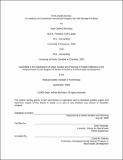Think inside the box : an analysis of converting commercial property into self storage facilities
Author(s)
McKinley, Sean Jeffrey
DownloadFull printable version (1.606Mb)
Other Contributors
Massachusetts Institute of Technology. Dept. of Urban Studies and Planning.
Advisor
John Kennedy.
Terms of use
Metadata
Show full item recordAbstract
The modern self storage facility is a multi-tenant operating business that reflects the needs of residential and commercial customers. The industry has evolved from a transition asset to a property type that adheres to location qualities that typifies those of the modern retail facility while conforming to the architectural and aesthetical qualities of the community. Unfortunately, the modern day storage developer confronts thirty plus years of negative public perception that is typically associated with this asset class. Recent court cases are utilized to distill a general thought pattern for why local municipalities are curbing new construction of this market demanded asset class. Given the mounting barriers to entry for self storage developers juxtaposed against the continued market demand for the product, the thesis attempts to find a middle ground for these market forces in the form of converting an existing commercial structure. Two facilities are extensively researched and used as a case study for establishing a model to emulate in future conversion projects. Utilizing existing precedents and additional market resources, a step-by-step qualitative and quantitative model is designed to assist in analyzing the probability of success for a future conversion opportunity. (cont.) Qualitatively, the first analysis for determining if storage conversion is applicable to the existing structure is done through the use of a feasibility analysis pertaining to the demographic attributes surrounding the property. If the property meets enough of the qualities associated with a successful facility then additional analysis is warranted. This analysis occurs on a quantitative basis using basic market and property variables to estimate the cost of construction and operating expenses associated with the region where the storage facility is located. The overall framework yields a general "go or no-go" model applicable for future self storage developers considering a property for conversion.
Description
Thesis (S.M.)--Massachusetts Institute of Technology, Dept. of Urban Studies and Planning, 2006. This electronic version was submitted by the student author. The certified thesis is available in the Institute Archives and Special Collections. Includes bibliographical references (leaf 107).
Date issued
2006Department
Massachusetts Institute of Technology. Department of Urban Studies and PlanningPublisher
Massachusetts Institute of Technology
Keywords
Urban Studies and Planning.